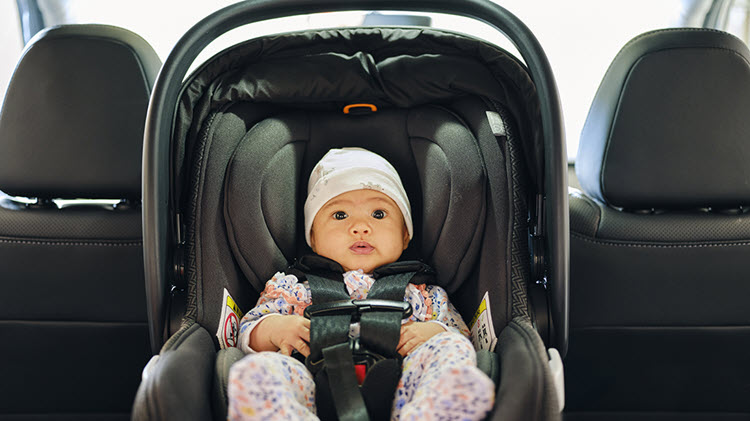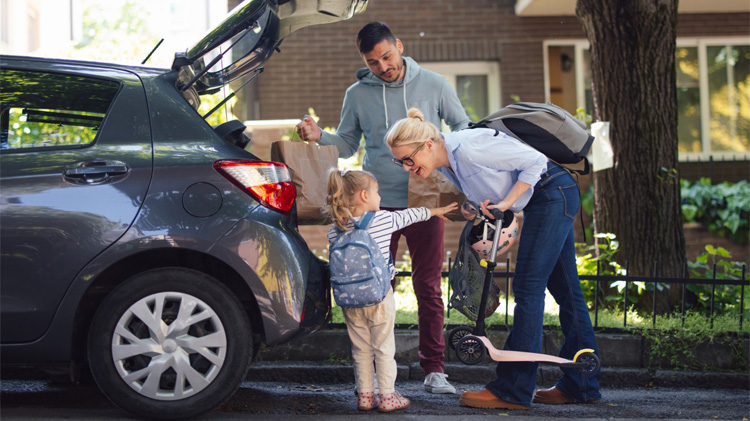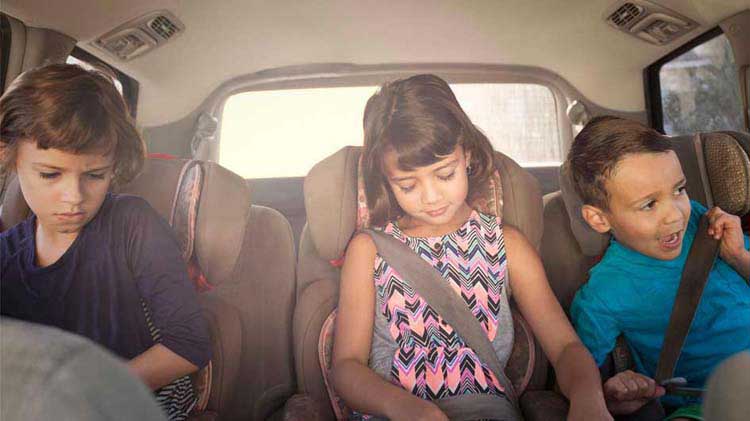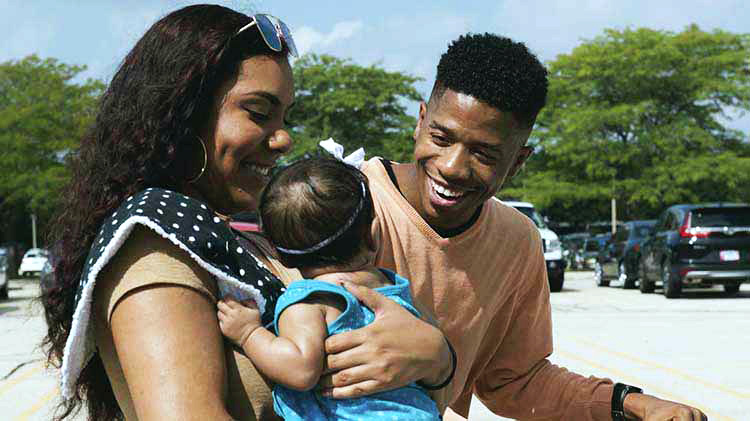Car seats and child passenger safety
Learn current car seat safety guidelines and backseat safety to help keep your child safe.
Are you certain you have the right car seat for your child and that you’re using it correctly? A new survey revealed that many parents do not know car seat safety guidelines or may be using seats incorrectly. State Farm® surveyed U.S. parents ages 25–55 to study how parents actually use car seats and found that 77% of parents did not know the age range covered by their state’s child restraint law — and nearly 1/5 admitted they did not use a child safety seat in their vehicle.
Child passenger restraint systems are essential to keeping children safer in a vehicle. Motor vehicle crashes are a leading cause of death for children in the U.S., according to the National Highway Traffic Safety Administration (NHTSA). When children are properly restrained in an appropriate child safety seat, booster seat or safety belt, their chance of being killed or seriously injured in a crash is greatly reduced. However, the survey found that nearly 1/4 of children who used a car seat while riding in a vehicle did not use them every time, and 28% of parents were not using the recommended type of safety restraint for their child.
“Today’s car seats are specially designed to keep children safer in case of a crash, but they won’t work if you’re not using the right seat or it’s not installed correctly,” says Laurel Straub, assistant vice president of Enterprise Research at State Farm. “With the work done by State Farm and The Children’s Hospital of Philadelphia over 25 years ago to create Partners for Child Passenger Safety, parents could understand the importance of car seat safety and learn how to take extra steps for safety every time they get in the car.”
From Car Seat to Driver’s Seat™, State Farm has been committed to the safety of its customers for over 100 years. To help keep your child safe, here is our comprehensive guide to car seat and child passenger safety.
Know your child’s height and weight
Contrary to what many parents think, it is height and weight — not age — that determines which kind of car seat to use. Keep your child rear-facing until they outgrow the car seat’s recommended height and weight range. Manufacturers are making seats to fit and keep children rear-facing long after their first birthday — for their safety.
In the study, reasons parents cited for not using child safety seats included the child not wanting to use it, the child being “too old” for the seat or the seat being inconvenient. Because safety is paramount, when driving in a vehicle, it’s crucial to follow recommended guidelines, regardless of the child’s age and attitude, to help protect them.
Securing kids properly is the number-one guideline for child passenger safety. Your child’s age, height and weight will determine whether they need a car seat, booster seat or seat belt. Identify the appropriate safety restraint for your child at nhtsa.gov.
Choose the right child passenger restraint
Based on recommendations from the National Highway Traffic Safety Administration, these child care seat guidelines can help you determine which child safety seat is right for your child at every stage.
Babies
For the best protection, use a rear-facing child safety seat for your baby until they reach the appropriate weight and height limit allowed by the seat manufacturer.
Toddlers
When your child has outgrown the rear-facing child safety seat, use a forward-facing child safety seat with a harness until they reach the highest height and weight allowed by the seat manufacturer.
Children age 4 to 8
When your child outgrows the limits for a forward-facing child safety seat, use a belt-positioning booster seat until the lap and shoulder belts fit properly. That usually happens between 8 and 12 years old and the child is at least 4 feet, 9 inches tall.
Older children
All children under 13 should always ride in the back seat. When your child is between 8 and 12 years old and is at least 4 feet, 9 inches tall, they should sit in the back seat and use the lap and shoulder belts.
How to install a car seat
So you’ve found the right car seat. Now sit down and read the owner’s manual and your vehicle’s manual. And follow each step as if your child’s health depends on it — because it does.
According to child safety seat statistics, properly installed and correctly used car seats can decrease the risk of a fatal injury by 71%–82% for children. The risk of serious injury for children age 4–8, when using a booster seat, is reduced by 45%. And for older children, the risk is reduced by 50%.
That said, installing car seats can be a little frustrating, and with recommendations constantly changing, it’s difficult to be sure you are meeting child car seat guidelines. Here are some car seat installation tips to help ease the headaches and keep your precious cargo safe and sound.
Babies
- Make sure straps fit snugly and the chest clip is at the armpit level.
- Make sure the top tether is connected. Check car and safety seat manuals for help with tether connections.
- Ensure the car seat is installed at the correct angle — infants need to be slightly reclined to keep their airways open.
Toddlers
- Make sure the slot through which the shoulder strap is inserted into the seat sits at or above the child’s shoulders.
Children age 4 to 8
- The seat belt should fit flat over the child’s hips and across the shoulder.
All seats
- Make sure it’s not too loose. In a crash, a loose seat provides less protection. Keep seats belted in when not in use or they could become a projectile.
- Use the inch test. Make sure you can’t move the car seat more than an inch in any direction. To test, tug hard on the base near the seat belt path opening.
- Secure your child correctly. All clips and buckles should be fastened and tightened so you can’t pinch extra webbing at the shoulder.
A great next step would be getting some child seat safety expert advice. And, fortunately, the non-profit Safe Kids Worldwide has pretty amazing resources. Attend a car seat safety check event hosted by Safe Kids Coalitions, serviced by more than 40,000 certified child passenger safety technicians all over the country. Find one near you and get your installation checked or have them help you install it.
The NHTSA also provides a valuable resource to parents and caregivers by providing help and support for car seat installation and inspection. All of their services are free, and you can find an inspection station in your area or set up a virtual appointment with a child passenger safety technician by visiting their website.
Pro tip: Attend an event or find a technician before your bundle of joy arrives so you’re ready to go from day one. You’ll learn and practice how to correctly use the car seat and adjust the harness. Make sure to adjust it again once your baby arrives to make sure the child is properly fitted.
Going the DIY route
Here are some helpful tips to remember:
- All car seats should be correctly buckled in the back seat.
- Once you install the seat, you shouldn’t be able to move it more than one inch in either direction at the belt path. You can do this by using the seat belt or the car seat LATCH system. Always use the top tether for forward-facing seats. Learn more about top tether car seats.
- The harness straps must be snug and the chest clip should be at armpit level. Don’t place heavy coats or blankets under the straps, and make sure the straps are not twisted.
Don't forget boosters
Older kids can also be at risk in a crash. Be sure to check guidelines for your child to continue using a booster seat according to their height and weight, not their age. In the survey, children aged 3 and older were significantly more likely to be using the wrong type of child restraint.
All grown up
When your child passes this Safe Kids Seat Belt test, it’s time to retire the booster.
- When the child’s back and bottom are against the vehicle seat back, their knees should bend at the edge of the seat.
- The lap belt should fit across the hips or upper thighs and not across the stomach area.
- And the shoulder belt should fit across the chest and shoulder and never across the neck or face. This means approximately 4 feet, 9 inches and 80 to 100 pounds. This is usually between the ages of 8 and 12 years old.
If they pass the above booster seat test, your child should be old enough and large enough to move to the vehicle’s seat, where the seat belt should fit properly over them to help restrain them in case of a crash. And it’s still best for them to still sit in the back seat away from air bags.
Protect all of your passengers
Back seat safety
Once your children age out of car seats, the back seat is still the safest place for your child. Most important, be sure all back seat passengers (children and adults) buckle their seat belts. Unrestrained adults can be injured in the back seat, too. They also can injure the driver if thrown forward during impact. For protection, have a single back seat passenger sit in the center seat — it is the farthest point from possible impact zones.
Shop for safety
Keep passengers in mind when you’re shopping for a new vehicle. Many newer models are equipped with advanced safety features, such as forward collision warning systems, adaptive headlights, blind spot detection, lane departure warning and backup cameras. Side airbags and inflatable seat belts offer more protection, while headrests can help reduce the occurrence of whiplash.
Drive cautiously
Make sure you’re always driving safely. Distracted driving is a leading cause of crashes, so put your phone away, give your children a book or movie to keep them occupied and always keep your eyes on the road.
Set an example
And finally, remember you as a parent are the number-one influence on your child’s in-vehicle behavior. You’re a role model for the type of driver your child may eventually become.
For more child safety seat statistics and insights from our car seat survey and tips to keep your child safe, visit our State Farm Newsroom article.




